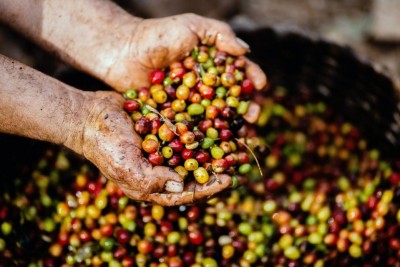Coffee is one of the world’s most widely consumed beverages, supporting a multibillion-dollar sector spanning a lengthy value chain from farmer to consumer. As coffee production is largely in the hands of smallholder farmers, like our coffee from the Inga Aponte tribe in Colombia. The livelihood value is immense, with an estimated 100 million coffee farmers worldwide.

HISTORY AND FACTS ABOUT COFFEE
Global coffee trade relies on two species: arabica that makes up around 60% of traded coffee, and robusta the remaining 40%. Coffee has been farmed for at least several hundred years and may have been wild harvested for millennia, first as a food and then later as a beverage. Farming of arabica was first recorded in Africa in the 18th century, but probably predates records by hundreds of years. Robusta coffee cultivation was first documented in the early 1870s, but despite great hopes, its cup qualities failed to meet the taste requirements of the consumer, and thus the aspirations of growers and coffee merchants.
Most consumers, and even many coffee sector representatives, are unaware that there are more than two or three coffee species. There are over 120 coffee species known to science, occurring naturally in tropical Africa, the Indian Ocean islands such as: Madagascar, Comoros Islands, and Mascarene Islands, Asia, and Australia.
SUSTAINABILITY OF THE COFFEE SECTOR
Despite the overwhelming agronomic and economic success of arabica and robusta bean, new threats are now evident for the global coffee sector. These include climate change. Such as our coffees from Brazil have been washed processed, but in the past few years the severe extention of draught pushed the farmes to use natural method to remove the coffee pulp. The increasing incidence and duration of drought is a huge problem, also the spread and escalating severity of devastating fungal pathogens, diseases and pests.
Given the importance for coffee sector sustainability, two critical questions come into focus: What is the extinction risk of wild coffee species? And which species should be prioritized for conservation and crop development?
AT LEAST 60% OF COFFEE SPECIES ARE THREATENED WITH EXTINCTION
The application of the IUCN Red List Categories and Criteria resulted in 75 coffee species (60%) being assessed as threatened with extinction, including 13 critically endangered, 40 endangered, and 22 vulnerable species. Madagascar has the highest number of threatened species (43). This statistic comes from a 2012 study “Predicting future trends and identifying priorities. PLOS ONE 7, e47981 (2012)”.
The most popular kind of coffee for commercial production, arabica, is already on the endangered species list. Researchers have revealed that arabica coffee could become extinct in as little as 60 years.
WHAT ARE COFFEE PRODUCERS DOING TO CHANGE THE WORRYING FUTURE STATISTICS?
To counteract climate change, farmers can protect their crops in several ways, like using shade trees to keep the plants cool and stabilize the soil. That is used to grow coffee in Guetemala Ceiba. Moving their farms uphill, or switching to more resistant varieties of coffee. Focusing on saving coffee’s natural environment is key.
Ethiopia recently created three new protected areas in an effort to save wild arabica coffee. Wild coffee is not only consumed locally but worldwide. It also serves as key breeding stock for new coffee varieties. As forest now covers less than three percent of the Ethiopian land surface, the country’s wild coffee populations are severely endangered. Back in 2007, schoolchildren from wild coffee areas wrote songs and poems and painted pictures highlighting the importance of wild coffee and the need to protect forests for the local population.
THE IMPORTANCE OF DIRECT TRADE COFFEE
Most of the time big coffee brands are interested in the volume of the crop. This leaves small farmers in a rather unsure situation. When production goes wry, these big corporations can move elsewhere, leaving these small farmers with no source of income.
This is where coffee brands such as Coffee People, that use direct trade come in to the picture. Direct trade is a term used by coffee roasters who buy straight from the growers, cutting out the traditional middleman. This means depending on the quality of the coffee bean the farmer will get paid a fair amount, with no unnecessary costs.
It is important to educate the farmers and give them access to information on how to save our beloved coffee. Since in Direct Trade the farmers have direct contact with coffee companies who can provide them with scientific information, there is still hope to postpone coffee becoming extinct in the next 60 years.
Used materals:
- https://advances.sciencemag.org/content/5/1/eaav3473
- https://edition.cnn.com/2019/01/16/health/coffee-species-extinction-climate-study-trnd/index.html
- https://coffeepeople.ee/en/menu/blog/articles/uudis/2020/11/18/robusta-bean
- https://medium.com/techtalkers/coffees-going-extinct-here-s-what-you-need-to-know-now-2a6c70fccf36
- https://perfectdailygrind.com/2018/01/what-does-direct-trade-really-mean/
- https://coffeepeople.ee/menuu/kohvi-uudised/artiklid/uudis/2020/03/03/oiglane-kaubandus-voi-otsekaubandus
- https://www.bfn.de/en/activities/international-nature-conservation/international-projects/ethiopia.html
- https://coffeepeople.ee/en/menu/blog/articles/uudis/2020/11/04/growing-coffee
